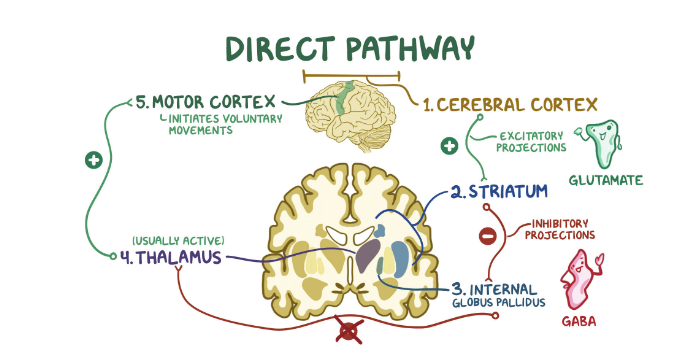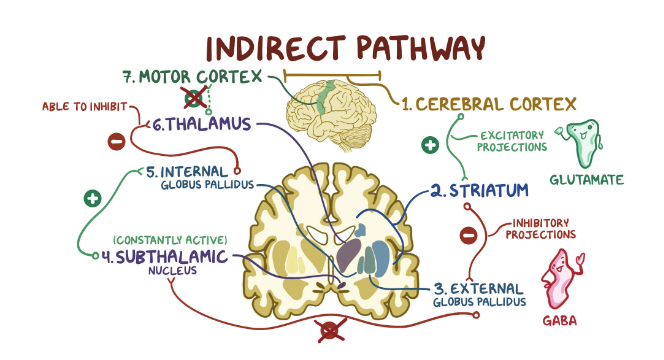Pathways and Structures:
Overview:
Parkinson's disease involves the degeneration of dopaminergic neurons in the substantia nigra pars compacta (SNc) which leads to the dysfunction within the basal ganglia, particularly affecting the direct and indirect pathways. (Note that these neurons produce dopamine, which is a neurotransmitter crucial for regulating mood, movement etc.) This results in the characteristic motor symptoms associated with the disease.
Basal Ganglia are a group of nuclei which are located deep inside the brain, which are involved in the regulation of voluntary motor movements, procedural learning, emotion and cognition
Loss of dopamine-producing neurons within the SNc disrupts the balance of neurotransmitters within the basal ganglia circuitry, specifically affecting the direct and indirect pathways.
How do they work?
- When a signal for voluntary movement is initiated, the cerebral cortex sends
signals to the basal ganglia (INPUT).
- The basal ganglia send signals to the thalamus and then back to the motor cortex
(OUTPUT). The cortex initiates movement via the spinal cord.
Pathways in Parkinson’s
Summary:
The loss of dopaminergic neurons in substantia nigra pars compacta which leads to the deficiency of dopamine (neurotransmitter that controls movement and coordination)
The direct pathway:
Helps to suppress unwanted movements and refine motor activity. It involves inhibitory projections from the striatum to the globus pallidus externa (GPe), which in turn inhibits the subthalamic nucleus (STN). The STN normally excites the GPi/SNr.
Dopamine normally acts on D1 receptors in the striatum, facilitating the direct pathway by disinhibiting the GPi/SNr. In Parkinson's disease, the reduced dopamine levels lead to decreased activation of the direct pathway, resulting in impaired initiation of voluntary movements.

Indirect Pathway:
Helps to suppress unwanted movements and refine motor activity. It involves inhibitory projections from the striatum to the globus pallidus externa (GPe), which in turn inhibits the subthalamic nucleus (STN). The STN normally excites the GPi/SNr.
With decreased dopamine levels in Parkinson's disease, there is decreased inhibition of the GPe, leading to increased inhibition of the STN. This results in reduced excitation of the GPi/SNr, further inhibiting the initiation of voluntary movements.
Parkinson's Disease is associated with protein accumulation, aggregation, mitochondrial abnormalities and neuronal loss in the substantia nigra. Check the Pathophysiology for more information.

